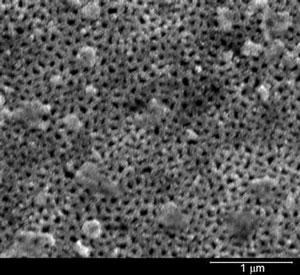| Jun 11, 2012 |
Ultrananocrystalline diamond-coated membranes show promise for medical implant applications
|
|
(Nanowerk News) Ultrananocrystalline diamond (UNCD) displays biological and mechanical properties that make it a promising choice for promoting epidermal cell migration on percutaneous implant surfaces. Percutaneous implants are commonly used for treatment of medical and dental conditions. Biocompatibility of the implant material plays a crucial role in preventing infections that cause premature failure.
|
|
Recent studies have shown that microporous membranes can facilitate migration of epidermal cells, enabling the development of a seal that resists movement of fluid and microorganisms and therefore improving the implant life.
|
|
A team of Center for Nanoscale Materials users from the University of North Carolina and North Carolina State University, working with the Nanofabrication & Devices Group, devised a simple but innovative approach that combines both of these aspects simply by coating silicon nitride microporous membranes with a conformal coating of ultrathin (~150 nm) UNCD films. The resulting membrane not only provides the required porous structure, but also offers exceptional mechanical and biocompatible properties (see paper in Journal of the Minerals, Metals and Materials Society: "Ultrananocrystalline Diamond-Coated Microporous Silicon Nitride Membranes for Medical Implant Applications").
|
 |
| SEM image of AAO membrane coated with tungsten followed by UNCD exhibits 30-to 50-nm pore diameter
|
|
The team demonstrated that their method also works on nanoporous anodized aluminum oxide (AAO) membranes that are coated with UNCD to reduce the pore size down to 30-50 nm. Scanning electron microscopy (SEM) and Raman spectroscopy were used to examine the pore structure and chemical bonding of the resulting membrane. Growth of human epidermal keratinocytes on uncoated and UNCD-coated silicon nitride microporous membranes was compared by using the 3-(4,5-dimethylthiazol-2-yl) 2,5-diphenyltetrazolium bromide (MTT) assay. Both membranes displayed increased cell growth due to their porosity, and the UNCD coating did not alter the viability of human epidermal keratinocytes. Because of its exceptional chemical and mechanical properties, it is expected that UNCD will provide a more stable implant-tissue interface than silicon nitride.
|

